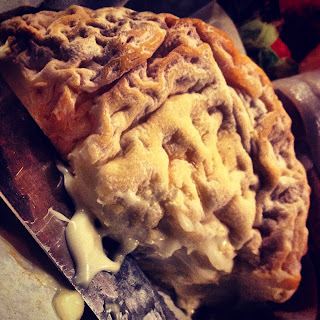Baby Brie Birth
19th August 2013
The slightly tangy, plump, rind bound disc of ripened cows milk found its furry feet in France in the 13 th century. In Robe, Simon Burr brought a swirling pot of Fleurieu milk up to a steady 36c at the Caledonian Inn two weeks ago. Spectating, stirring and turning, I was astounded by the importance of accuracy in measurement, time, temperature and technique. Thoughts ventured back to the centuries nearer to the Brie's birth to those Artisans without the shiny thermometers.
Fleurieu cows milk teemed into the immaculately sterile saucepan between beautiful blobs of cream that surfaced in the bottle, thanks to the unhomogonized nature of the creamy yellow dairy. The milk to be cheese, must be of a pasteurized source, says the rule in Australia. French born Louis Pasteur's discovery of pasteurization now has endless circles of flavour chasers beckoning the return of raw milk for artisan cheese. Where pasteurization is a heating of a perishable food product to destroy harmful pathogens, the heating process is believed by some to detrimentally diminish the flavour of milk. In the context of cheese, the milk building blocks of mystery of flavour are lacking from the very start, if true! May this perhaps be explored in the near future for the benefit of our Sunday afternoon cheeseboards...
The starter culture over night transformed into a substance alike to homemade set yoghurt. This starter is a bacteria that feeds on the lactose in the milk, producing a product of lactic acid - the origin of the wonderful tang we savour in the tasteful smelly parcels. The starter was added at 10.25 am Wednesday morning. Stirred in with no trace of a lump, the temperature of the creamy yellow goodness read a perfect 36c. (The starter solution is prepared earlier to allow time to check that the starter is active. A positive result, is that the starter will set a small volume of milk in given time.) An 11 am scheduled check of the milk to assess the ripening process resulted in smiles.
The curdling - the close to instantaneous coagulation of a fluid body of milk, into a set mass alike to silken tofu. The addition of rennet is the catalyst for this. Historically, concocted with lining from the inside of a calf's fourth stomach... However, we used the common synthetic, vegetarian version, chymogen. The active enzyme in the rennet speedily brought us to a stage where the utensil in Simons hand needn't be a spoon but a knife. Cutting symmetrically to allow increased surface area for the newly born whey to drain from their neighbouring curd. The solid components being tucked into their moulds for further draining, turning and spraying with spores. Adopting a taught and shapely physique, after five regular turns over the space of eighteen hours, the round discs were immersed in a bath of 20% brine for 30 mins. The baby Brie equipped with an injection of preservation before further inoculation of the white mould spores.
The technicalities of accurate measurement of the cheese's perimeters of time and temperature eased. The following days were a relaxed rhythm of turning for internal distribution of the moisture, requiring less and less physical nurturing. Their plump round bodies were bound snuggly in cheese paper Saturday, for a further week in a non refrigerated environment. A further 8-12 weeks in a maturation cellar at 8 to 12 degrees, 90% moisture will be mimicked in the cool, damp Caledonian Inn cellar.
The patience challenge of abstaining from curling open a corner and indulging in a curious nibble, will have to keep intact.


